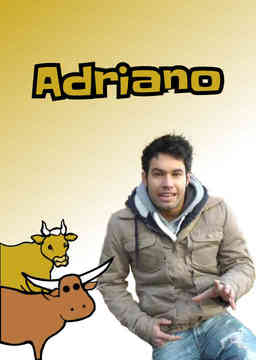









Difficulty:
 Adv-Intermediate
Adv-Intermediate
Italy
Claudio Capotondi is a sculptor who lives and works in Pietrasanta, a Tuscan town famous for its marble and marble sculptors. He talks about an upcoming exhibition.
Difficulty:
 Adv-Intermediate
Adv-Intermediate
Italy
Claudio Capotondi, sculptor, takes us into his "thinking room" and talks about the process of taking a block of marble and turning it into a work of art.
Difficulty:
 Adv-Intermediate
Adv-Intermediate
Italy
The artist takes to the fascinating world of the marble quarries where he chooses the blocks of marble which he will transform into works of art.
Difficulty:
 Adv-Intermediate
Adv-Intermediate
Italy
Claudio Capotondo talks about the tools and techniques that enable him to transform a block of marble or porphyry (a kind of igneous rock) into a work of art.
Difficulty:
 Adv-Intermediate
Adv-Intermediate
Italy
"Innercore" is the title, inspired by an article in the New York Times, of Claudio Capotondi's masterpiece. He talks about the significance of the sculpture, and about the special kind of stone he used to make it.
Difficulty:
 Adv-Intermediate
Adv-Intermediate
Italy
Claudio Capotondi discusses his marble and travertine sculpture entitled PortaRoma, created in 2000.
Difficulty:
 Beginner
Beginner
Italy
This is part of a film, Capriccio all'italiana shot in 1967-1968. This episode was directed by Pier Paolo Pasolini. The singer is Domenico Modugno, and you'll also see Totò. This was Totò's last film appearance.
Difficulty:
 Adv-Intermediate
Adv-Intermediate
Italy Sicilian
Giuseppe Pitrè was an ethnologist who collected documents pertaining to Sicily and its culture and traditions. His work is the basis for this documentary, which unites live footage, drawings, and archival documents.
Difficulty:
 Adv-Intermediate
Adv-Intermediate
Italy Sicilian
We learn about Pitrè's life, and his relationship to the sea.
Difficulty:
 Adv-Intermediate
Adv-Intermediate
Italy Sicilian
In this segment, we see some swordfish harpoon fishing, and hear an old Sicilian legend about a boy named Nicola who could stay underwater for a very long time.
Difficulty:
 Adv-Intermediate
Adv-Intermediate
Italy Sicilian
Pitrè's life was marked by a sort of travelling storyteller tradition in his family. In those days, a cuntastorie (storyteller) would go around to all the piazzas and tell stories, and people would pay to hear them.
Difficulty:
 Adv-Intermediate
Adv-Intermediate
Italy Sicilian
This segment focuses on an actor who retells and acts out stories from Sicily's past, speaking in Sicilian dialect. He uses the Pitrè Museum as a source for material. The museum houses a manuscript with over 4,000 Sicilian proverbs, just one of the many volumes of Sicilian ethnographic material.
Difficulty:
 Adv-Intermediate
Adv-Intermediate
Italy Sicilian
Pitrè's mission was to conserve and safeguard the traditions of his people, the Sicilians, and to keep the roots alive. Looking at religious traditions is one important way to do this.
Difficulty:
 Adv-Intermediate
Adv-Intermediate
Italy Sicilian
Saint Rosalia (1130–1166), recognized by her crown of roses, is Palermo's patron saint. The video shows the July 14 parade in honor of the saint, and a young man who credits his cure from a grave illness to Saint Rosalia.
Difficulty:
 Adv-Intermediate
Adv-Intermediate
Italy Sicilian
The segment concentrates on the richness of the Sicilian dialect, a dialect which is less and less spoken. The narrator interviews two poets who recite their works in Sicilian, providing insights into the language.
Are you sure you want to delete this comment? You will not be able to recover it.